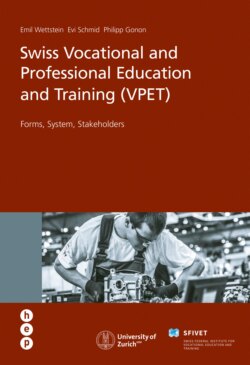Читать книгу Swiss Vocational and Professional Education and Training (VPET) - Philipp Gonon, Emil Wettstein - Страница 38
На сайте Литреса книга снята с продажи.
1.11 Professional colleges
ОглавлениеProfessional colleges (höhere Fachschulen, HF) are a new type of school in the area of tertiary-level professional education (cf. Fig. 1-8, p. 61). They train professionals and managers who often have a bridging function between theory and practice. The courses comprise at least 3,600 hours of training for programmes based on a relevant Federal VET Diploma, or at least 5,400 hours of training for programmes based on another diploma from upper-secondary level (FDEA Ordinance of 11 March 2005 on the Minimum Requirements for the Recognition of Courses of Study and Post-Graduate Programmes at Professional Colleges (Verordnung des EVD vom 11. März 2005 über Mindestvorschriften für die Anerkennung von Bildungsgängen und Nachdiplomstudien der höheren Fachschulen), (MiVo-HF, 2005, Art. 3, para. 1). Programmes at professional colleges can be completed as full-time courses or on a part-time basis and last for at least two years or at least three years respectively. A good half of the diplomas awarded in 2010 were for part-time programmes (Federal Statistical Office; FSO, 2011a).
Throughout Switzerland, there are a total of 33 core syllabuses with 52 specialisations overall, which are implemented in more than 400 recognised programmes (cf. Tab. 1-1).
The number of professional college qualifications has greatly increased in recent years. In 2013, more than 7,600 qualifications were handed out. Around a third of the diplomas concern programmes in the health care sector – in particular the programmes for registered nurses at Swiss professional colleges (dipl. Pflegefachfrau HF/dipl. Pflegefachmann HF) – and in the area of technology (cf. portrait of Serkan Kiziltoprak, p. 66). In addition, there are the qualifications of continuing education and training courses at professional colleges: in 2013, there were around 1,100 of these, with about half of them obtained in the area of economics (FSO, 2014e).
| Area | Core syllabuses |
|---|---|
| Technology | Technology with programmes in the following specialisations: construction site management, construction planning, electrical engineering, building services technology, wood science, information technology, food technology, mechanical engineering, media, metalworking, microtechnology, systems engineering, telecommunications, textiles, business processes |
| Hotel, restaurant and catering branch, tourism and hospitality services | Hotel, restaurant and catering, tourism, hospitality services |
| Economics | Agribusiness, banking and finance, business administration, pharmacy management, marketing management, legal assistance, textile economics, insurance, business informatics, customs administration |
| Agriculture and forestry | Agricultural engineering, forestry |
| Health care | Activation therapy, dental hygiene, medical-technical radiology, biomedical analysis, surgical technology, orthoptics, nursing, podiatry, paramedicine |
| Social work and adult education | Adult education and training, child education, social pedagogy, socio-educational workshop management |
| Art and design | Core syllabus in design with the following specialisations: fine arts, communication design, product design |
| Traffic and transport | Air navigation services, air traffic control, charter aviation |
Table 1-1: Professional college core syllabuses by areas. Source: Federal Office for Professional Education and Technology; OPET, 2011a
Professional colleges provide their graduates with very good opportunities on the labour market, since these courses combine practical competences with theoretical knowledge. Studies on the return on investment in education and training also show that the labour market attaches a clearly higher monetary value to qualifications of tertiary-level professional education (tertiary B level) than those of higher education institutions at tertiary A level (e.g. universities of applied sciences; cf. Cattaneo & Wolter, 2011). Nevertheless, professional colleges are often called “wallflowers of tertiary education” (e.g. Tommer, 2010, p. 5). One reason for this is no doubt their competition with the universities of applied sciences, which is reflected in the question of the titles, for instance: while studies at a university of applied sciences are completed with a Bachelor’s or Master’s degree, graduates of a professional college receive a federally recognised tertiary-level qualification (eidgenössisch anerkanntes Diplom). Professional college graduates are, therefore, disadvantaged on the labour market, so that internationally compatible titles have been demanded from various sides (cf. Schmid & Gonon, 2013).
Figure 1-9: Qualifications at professional colleges in 2015 by programme. Soure: FSO (2016b)
Other points for discussion include funding – on average, professional (college) students pay much more for their studies than students at a university of applied sciences (FH) (cf. Chapter 2.6.1, p. 137) – and a more clearly defined differentiation between the occupational profiles of graduates from programmes on the tertiary B and the tertiary A level. The last point concerns the health care sector in particular because, for instance, the training for registered nurses can be completed either at a professional college or at a university of applied sciences today, with the qualifications Registered Nurse, Advanced Federal Diploma of Higher Education (dipl. Pflegefachfrau/Pflegefachmann HF) or Bachelor of Science in Nursing at a university of applied sciences (Bachelor of Science in Pflege FH) respectively. The majority of Registered Nurses are trained at professional colleges today: in 2014, more than 1,700 diplomas were handed out for Registered Nurses from professional colleges (Federal Statistical Office; FSO, 2015a) – this programme is by far the most popular programme at professional colleges (cf. Fig. 1-9).
